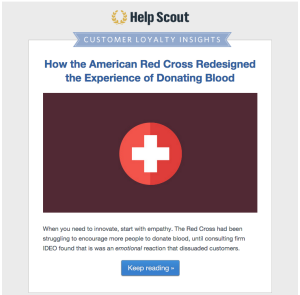Are catalogs still relevant? Should ecommerce brands be setting aside portions of their quarterly budgets to print and send physical catalogs as a way to drive repeat sales and awareness? What should they look like? How should they be formatted?
These are questions I’ve been wondering about lately as I read more and more stories about ecommerce brands dipping their toes in the physical, brick-and-mortar world of retail.
A quick search on Google reveals that I’m not the only one thinking about it. Although it’s not a completely saturated and well-covered topic, there are a few of interesting articles that have popped up over the past few years:
- Are Catalogs Making a Comeback in eCommerce? from Sweet Tooth Rewards
- The Revival Of Print Catalogs In Ecommerce Marketing from ReferralCandy
- Why the Top Ecommerce Brands Are Moving Into Physical Retail from Shopify
In a quest for more answers, I recently spoke with two influencers in the space who provided great insight on the topic of whether ecommerce brands should invest in (or a least test) physical catalogs.
In this post, you’ll get to read through the insight they shared, find out what I think, and get recommendations on how to decide if producing a physical catalog is a worthwhile tactic to test for your ecommerce brand.
Leslie Linevsky, Co-founder at Catalogs.com
The first person I spoke to was Leslie Linevsky, Co-founder at Catalogs.com. According to their website, the Catalogs.com mission is, “to create one place for online shoppers to find everything they need – while getting fantastic savings coupons on 1,000`s of products. We want you to find both big brand name stores and niche retailers in a fun and interactive shopping website with innovative online stores, print and digital catalogs.”
Catalogs.com has been around for over 20 years, so needless to say, they have A LOT of experience when it comes to ecommerce, retail, and the art of catalogs.
Here’s what Leslie had to say:
William Harris: “Are catalogs still relevant?”
Leslie Linevsky: “The answer, unequivocally, is YES. Print catalogs continue to be a powerful tool to drive ROI. However, most really successful retailers are now using both print AND digital catalogs as part of their overall strategic marketing plan. Print drives consumers to websites, where most consumers are now very comfortable taking the SKU #s found in a print catalog and then going online to order from retailer’s website. Of course, there are still many consumers who prefer ordering over the phone with a retailer’s 800#. However, digital catalogs are gaining speed because of their multi-function approaches, including email, SMS/Texting, mobile phone abilities, etc.”
Harris: “Why do we see less catalogs than we used to a decade or two ago?”
Linevsky: “Retailers continue to struggle with the rising costs of postage rates, higher production rates and the ever-looming negative environmental impact found in producing and mailing print catalogs. As marketing budgets get re-allocated, many retailers are definitely scaling back the number of catalogs they mail and are being more selective to whom they are mailing to. Digital catalogs, on the other hand, add a nice balance of being able to “touch” consumers more frequently at a fraction of the cost compared to print, affording retailers to send print less often while still increasing penetration by using digital. Print catalogs will continue to have an important place in the mix.”
Harris: “How are catalogs different today versus a decade ago?”
Linevsky: “Many print catalogs are being used much differently today than in years past. We see many retailers taking a more creative approach in communicating their brand image through print, both in a more memorable and in a more impactful way. Print these days is less “product specific” and more about branding. Individual digital catalogs are being used both to market specific lines, specials, and full company branding while staying within a retailer’s marketing budget.”
The insight I got from Leslie was great, but in order to make a decision about whether I think ecommerce brands should test catalogs, I wanted to talk to one that was actually producing and sending them to subscribers. So next, I reached out to Adam Bridegan, Vice President, Digital at Rhone.
Adam Bridegan, Vice President, Digital at Rhone
To gain more perspective on the subject, I also spoke with Adam Bridegan, Vice President, Digital at Rhone. The Rhone team creates activewear clothing for men—clothing that looks good and feels good no matter what you’re doing. Rhone recently started sending catalogs to subscribers—I wanted to know why they chose to do it and how it’s been going.
Here’s what Adam had to say:
William Harris: “When did you first create your catalog?”
Adam Bridegan: “Early 2016.”
Harris: “Why did you decide to create and send out a catalog?”
Bridegan: “We did a lot of research from other ecommerce brands and they had success with it.”
Harris: “Has it been successful for you? In what ways?”
Bridegan: “Absolutely. The data sophistication that most digital marketers look for today can trace to roots to direct response catalog. Most large direct mail companies employ teams of data scientists to create lookalike audiences, similar to Facebook advertising. It’s been great for new customer acquisition as well as customer retention.”
Harris: “How do you measure success?”
Bridegan: “ROI, Conversion Rates, Average Order Value, Revenue per Catalog, New Customers, Orders from existing customers, etc . We also measure direct search traffic after each catalog mailing.”
Harris: “What tip would you give to an ecommerce business owner looking to create their first catalog?”
Bridegan: “Do your research, speak with other brands and go with a reputable direct mail company with years of experience. Many successful brands rely on catalogs as a very important marketing channel, so don’t overlook it.”
Harris: “Anything else to share that could help other ecommerce business owners?”
Bridegan: We use Epsilon as our data provider and we also launch display remarketing and lookalike audiences from our catalog results with Conversant. We share our customer & email data from Shopify with Epsilon so they can track purchases for attribution. We send to our customers as well as lookalike audiences that Epsilon has categorized from other buyer cohorts. We saw much higher AOVs with catalog customers (tended to skew a little older than our website profiles). Also great for customer retention and activation. We plan on allocating 4-4x our initial budget from 2016 when we tested it. We plan on testing Pebble Post direct mail this year as well.
Should You Test Catalogs?
Yes.
After talking to both influencers in the space, here’s what I’ve decided: catalogs are worth trying if you have the budget available. I think in order to see any sort of ROI, it’s also essential that you have enough inventory, an interesting enough story, a big enough existing mailing list, and a solid design team. If you have all that, it’s worth giving it a go.
Maybe…
If you don’t have the budget to send physical catalogs but you still want to try, make a digital catalog and spend some of your digital marketing budget promoting it. Put some time and effort into drumming up excitement about it, tie it to a specific season (like spring or summer), and see how it impacts website traffic, brand awareness, and sales.
Not Yet.
If you’re inventory is small, you haven’t taken the time to develop your brand story, and you’re going to have to hire external freelancers and consultants to help you produce a catalog, it might not be the right time to test it for your ecommerce brand.
As you can see, I think whether you ultimately decide to test really comes down to what you know about your business and your audience. It’s not an unequivocal yes or no either way—you have to evaluate a number of factors to decide if it’s the right move for your business.
Saying Yes to Catalogs? Follow These Recommendations
If you do decide to move forward with testing catalogs, keep the following recommendations in mind:
Recommendation #1: Tell Stories. As you read from Leslie Linevsky’s answers above, catalogs have changed in the past decade. They are much less focused on explicitly featuring products, and much more focused on telling stories. When you put your catalog together, make sure it follows a recognizable theme, and make sure it connect with your target audience. Your job isn’t to sell to them. Your job is to make them want to buy. You do it with storytelling-driven imagery and text.
Recommendation #2: Feature Your Products in Real-Life Situations. Instead of featuring your products alone on top of a white background, include visuals of people using your products. Again, it goes back to telling stories. People want to see your products being used, and they want to be able to easily imagine themselves using your products. Use compelling photography to show people what it’s like to interact with your products in real-life.
Recommendation #3: Keep Your Pages Simple. Catalogs of the past used to be cluttered with imagery and texts—now they are much more simple. Implement the same or similar design principles that you implement on your website today when you go to build your catalog pages. Utilize white space, use crisp, high-quality visuals, don’t overdo it with variations in colors and fonts.
Over to You
Have you been testing catalogs to boost awareness, drive more traffic, and increase sales? Tell me about it, I would love to hear from you!
Digital & Social Articles on Business 2 Community(81)
Report Post






